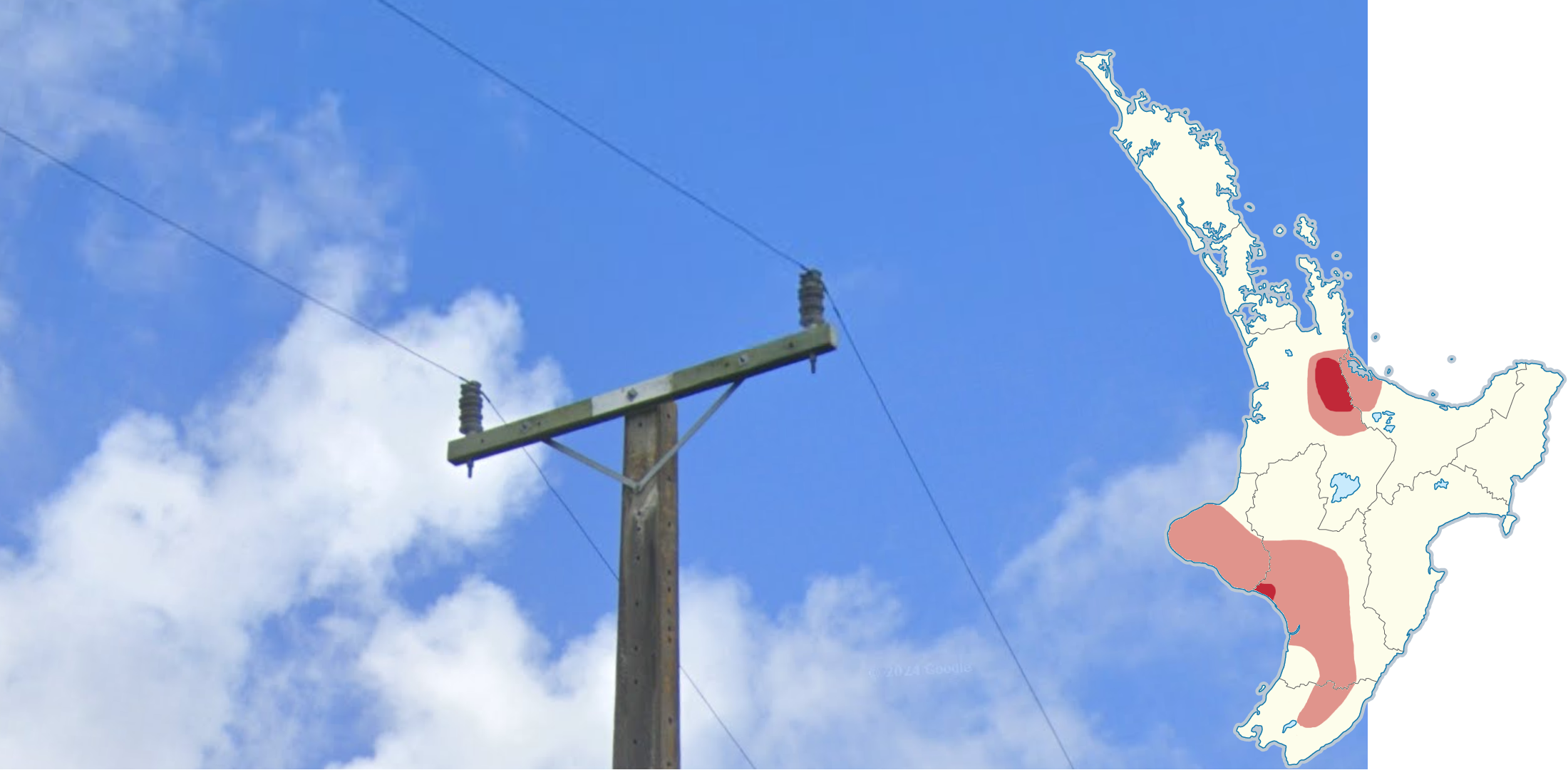
New Zealand
Bollards in New Zealand have a red strip which wraps around the top of the bollard. This strip wraps the whole way around the back and part of the front. The front or back of the bollard often contains a thin yellow or white reflector.
NOTE: These bollards are unique to New Zealand.
The most common pole type found in New Zealand is made of concrete and has one long indent which runs most of the way up the pole. Most concrete poles have small silver possum guards. Circular wooden poles can also be found, but are less common. You can also see concrete holey poles in New Zealand.
The majority of directional and warning signs in New Zealand are held up by white posts. Warning signs are diamond-shaped and painted yellow.
New Zealand normally uses white outer road lines. Yellow dashed outer road lines can be seen in populated areas. Roads with no outer lines can be seen on smaller roads. Inner lines are either a single dashed white line or unbroken double yellow lines.
NOTE: Australia does not have yellow inside lines, apart from regions with snow.
New Zealand uses black-on-yellow chevrons with a thin black border. White on black chevrons are very rarely used.
NOTE: Australia’s chevrons have the same colours, but do not have the border.
Bridge markers can be found on most paved roads in New Zealand. If the sign is on a state highway, the highway number will always be shown in a red crest on a white marker. The yellow marker indicates the name of the river or bridge.
NOTE: Some bridge markers indicate very small streams or culverdens which can be hard to find.
Two-digit state highway numbers follow a sequential pattern from North to South, making them easy to find. Single digit highways run through large parts of the country, but are easy to remember due to the small number of them.
NOTE: Bollards can sometimes have highway numbers written on them.
You can click on the image to enlarge it.
The first digit of Fonterra farm signs follows the regional pattern seen on the map.
This image was provided by snowf_lake and brainy. You can click on the image to enlarge it.
The Waikato and Northland regions are characterised by their drier climate and rolling hills. In particular, the Northland region is quite hilly.
NOTE: This type of landscape can be found in other parts of the North Island, but is more common in the mentioned regions.
Bright sandy cliffs are a common sight in the central region of Manawatū-Whanganui. They may also be found in parts of Taranaki, Waikato and a road going into Hawke’s Bay.
NOTE: Sometimes the cliffs may appear like sandy rocks.
Tall hedge and tree rows are particularly common in the Canterbury region. They are mostly found in the Canterbury plains, which comprises very flat, large fields.
Due to Canterbury’s flat landscape, mountains can often be seen in the distance to the west.
NOTE: Hedges that are even taller are common near Tauranga.
Very tall hedges are found in the Bay of Plenty, mainly around Tauranga.
NOTE: Noticeably lower, but still tall, hedges are commonly found in Canterbury.
While New Zealand flax can be found across the country, if you see them in long neat rows, you should consider Southland.
Poles with the middle insulator being installed on top of a tall metal bar are often found along the Auckland Waikato border, as well as in other parts of Waikato.
NOTE: Insulators installed on significantly shorter vertical bars are rarer and can be found all across the country.
A long black vertical sticker with 6 digits with a small black square beneath it, is found on most of the North Island, in Southland and in Otago. On the North Island the first digit will be a 3 or a 4, while on the South Island it starts with an 8.
NOTE: There is a similar regional black sticker with 6 digits but without a small square below it. Additionally, the sticker can rarely be white.
Similarly, a small white horizontal pole sticker with several numbers is found in several parts of the North Island.
NOTE: The edges of the plate must be straight, meaning they cannot be rounded. Rounded plates are seen all across the country.
Solid outer white lines without middle lines are most common in Gisborne, but can also be found in northern Hawke's Bay and Wellington.
NOTE: The roads in Wellington are typically narrower.
Wooden fences with tightly packed fence posts are most common on the Northern Island and the north of the South Island, as well as on Akaroa.
In 2011, Christchurch was hit by an earthquake. As a result, roads on coverage from 2012 often appear in quite bad shape. Water damage caused many driveways to be cut off from streets due to large puddles of water, dirt or mud.
Due to this reason, many residential houses in the city had to be removed, leading to several districts on newer coverage appearing like normal suburbs, but with almost no houses. This is noticeable when looking at where former driveways used to be.
Blenheim can be recognized by having a large range of hills to the north and the south of the city.
Banks peninsula, also known as Akaroa, is rocky with grassy hills, and small patches of trees.
NOTE: This region can sometimes have gorse, which are also commonly found on the Otago peninsula.
The region of northern Marlborough, known as Marlborough Sounds, has densely forested mountains protruding from water.
NOTE: Northern Marlborough is almost exclusively in Generation 4.
The Otago peninsula east of Dunedin is recognizable from its combination of plants such as cabbage trees, yellow flowered bushes, small groves of cone-shaped pine trees, and New Zealand flax. Additionally, the peninsula’s poles often have off-centre crossbars.
State Highway 73, located near Arthur’s Pass, can be recognised by the almost dried out river with an abundance of gravel on the river bed. Additionally, the Street View car in Arthur’s Pass drove behind a black pickup truck with two ladders on its roof.
State Highway 94 is characterised by its dense red beech forest surrounded by snow-capped mountains.
GeoGuessr’s own official maps are not very good, for a variety of reasons. Plonk It recommends you play these maps instead:
In addition, here are some resources to help you practise New Zealand:
Plonk It New Zealand (map link) - This map contains locations for practising each meta in the Plonk It New Zealand guide from step 2 to 3.
The Ultimate New Zealand guide (link) - This guide was written by Brainy, and it contains an extensive list of metas for region guessing New Zealand.
Many pole metas were discovered by Binull.
This guide also sourced many others, including weett’s google car & season meta document.
Pole Markings guide (link) - This guide by Lupus covers many pole plates, stickers and so on. Useful if you wish to master New Zealand.
Street Signs of New Zealand guide (link) - This document by fie summarises all of the regional street signs in New Zealand. Highlights differences between less distinct signs.
Fonterra Farm Guide (link) - Not just the first digit of the fonterra farm numbers are regional. This guide by snowf_lake covers the regions of the 2nd digit.
Several of these resources contributed to the development of this guide.











































































